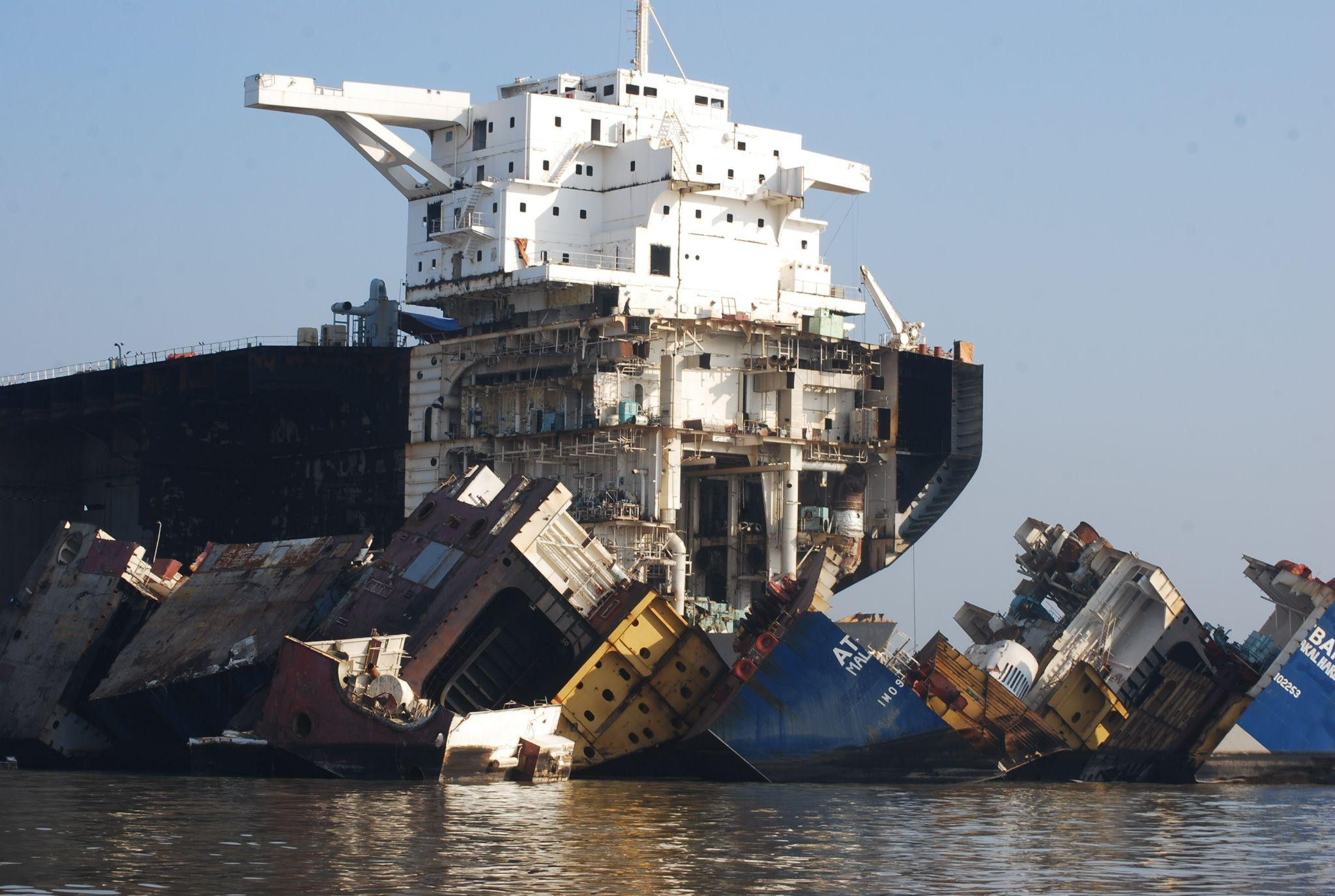One part of the maritime industry that gets little attention is shipbreaking. Large vessels need to be broken down at the end of their useful life, and the international maritime workers who perform this task face serious dangers when it is performed without protective gear and environmental regulations.
What Is Ship Breaking and Where Is It Done?
Shipbreaking or ship recycling is the process of tearing down large hulled ships for scrap, recycling, and disposal. Even the largest ships are completely stripped and separated into their component parts and scrap materials.
Shipbreaking can take place at a pier, drydock, or specialized ship breaker yards, although the vast majority of shipbreaking happens in South Asian countries and often takes place on the unprotected shore. International ship breakers in places like India and Pakistan break down oil tankers and cargo ships, often without protective gear or safety training.
Some percentage of ships are recycled in the United States, where regulations require safe and environmentally sound shipbreaking practices. However there are still places in the U.S. where shipbreakers are not provided the proper protection against the inherent dangers of their work, and many maritime injuries among shipbreakers go unreported.
What Are the Risks of Shipbreaking?
OSHA guidelines outline the risks associated with shipbreaking as part of the Shipyard Industry Standards Title 29 Code, part 1915. In the United States, OSHA can conduct targeted inspections of known shipbreaking operations to enforce the standards of workplace safety.
Hazardous Shipbreaking Activities
OSHA has identified the following hazardous activities that ship breakers perform:1
- Entering and working in confined spaces and dangerous atmospheres
- Paint removal
- Metal cutting and handling
- Industrial truck operations
- Working on elevated surfaces, especially near edges and deck openings
- Removing bilge and ballast water
- Removing and cleaning of oil and fuel tanks
- Operating cranes, lifts, and other gear
- Cutting and welding metal
- Use of compressed gas
- Working on scaffolds, ladders, and other temporary structures
Unsafe Work Conditions and Practices
In addition, OSHA has outlined unsafe work conditions and practices that can cause injury:1
- Inadequate training for workers
- Inadequate personal protective equipment or PPE
- Insufficient fire prevention and protection measures
- Delayed or lacking access to emergency response, rescue, and first-aid personnel
Exposure to Hazardous Materials and Conditions
Workers performing the work of shipbreaking may also be exposed to dangerous materials that are known to cause health problems, including:1
- Asbestos, which is found in insulation, hanger liners, gaskets, and valve packing
- PCBs, or polychlorinated biphenyls, which are found in rubber hoses, some paints, and under hull plates
- Lead, which is found in marine paints, batteries, and lead ballast
- Many hazardous chemicals and materials like refrigerant CFCs and heavy metals including mercury
- Excessive noise caused by hammering, metal cutting, and grinding
- Smoke and fire from burning insulation, lagging, fuel, and flammable lubricants
Environmental Risks of Shipbreaking
Most of the world’s ships are broken down in Pakistan, India, and Bangladesh. While the materials are reused, environmentally sound recycling practices are rarely employed in South Asia. The environmental costs of unregulated ship recycling are high and the impact to public health can be long lasting and go unreported.
Not only are these workers exposed to the risks of shipbreaking themselves, their communities are subject to toxins from waste, fuel, and oil being dumped into the ocean. Marine life and food sources can be contaminated. Fumes and air quality hazards are released by burning and leeching, which contaminates the soil and drinking water.
Protecting Shipbreakers and the Environment
Ship owners and salvage facilities that protect maritime workers and the environment do exist, and supporting the industry in the United States provides a responsible and environmentally friendly option for fleets even though the costs are higher. In the long term, protecting injured workers and their families is the ethical and responsible approach to shipbreaking.
In the U.S., shipbreaking yards must properly recycle all hydrocarbons, lead paint, asbestos, and PCBs. All government ships are required to be dismantled in the United States, and the need for well-trained shipbreakers is growing. Under maritime laws like the Jones Act and the Longshore and Harbor Workers’ Compensation Act, workers who are injured in the shipbreaking industry are entitled to full and fair compensation for their injuries.
Legal Options for Injured Shipbreakers
When a worker is injured in ship breaking, in ship building, or in service to a vessel, there are many different aspects of maritime law to consider. There are protections that may apply to your situation that can offer compensation for medical expenses, long-term disability, loss of earning potential, and even pain and suffering if negligence was a factor in causing the injury.
If you or a family member has been injured or contracted a long-term illness from exposure to the hazards of shipbreaking, consult with an experienced maritime injury lawyer to learn what maritime laws may apply to your case. At Maintenance and Cure, our team has recovered millions of dollars in fair compensation for maritime workers nationwide. Contact us today for a free case evaluation.
Source:

